一、什么是WebService
WebService是部署在Web上的,可访问的应用程序。主要是对外提供业务接口(业务功能)。
日常生活中的WebService:比如:天气预告、查询手机归属地。
二、WebService的组成

WebService工作图
说明:
- 注册方:表示服务都要在注册服务器中进行注册,比如:服务的地址、接口、接口的方法等;
- 服务提供者:服务的实现方;
- 服务消费者:服务的调用方(客户端),广义来讲:Web应用,APP、组件等等。
三、WebService技术标准
- xml技术,web服务具体平台无关性、语言无关系;
- soap协议, Simple Object Access简单对象访问协议;
- wsdl web服务的描述语言(xml文档),用于描述web服务
Dubbo
四、Restful服务(重点)
- json数据格式的交互
- http协议
- 无需wsdl
Springcloud+Springboot
五、开发传统WebService
Apache CXF=Celtix+Xfire,开始叫Apache CeltiXfire,后来更名为Apache CXF了,以下简称为CXF。Apache CXF。Apache CXF是一个开源的Web Services框架,CXF帮助您构建和开发 web Service,它支持多种协议,比如:SOAP1.1,1.2XML/HTTP、RESTful或者CORBA。
CXF是基于SOA总线结构,依靠Spring完成模块的集成,实现SOA方式。
六、开发WebService的步骤:
服务端
![]()
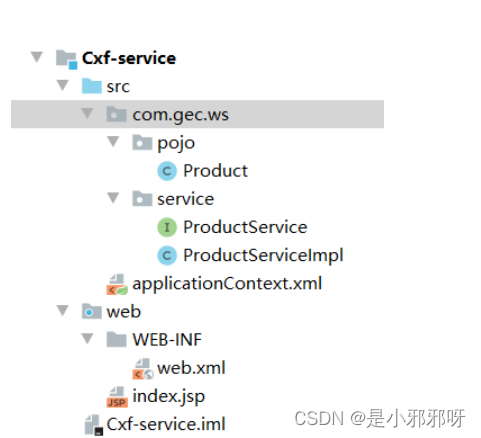
服务端架构图
①创建服务端Web项目,导入CXF的类库。
![]()

导入CXF类库
![]()

导入CXF类库
②配置web.xml文件
<?xml version="1.0" encoding="UTF-8"?>
<web-app xmlns="http://xmlns.jcp.org/xml/ns/javaee"
xmlns:xsi="http://www.w3.org/2001/XMLSchema-instance"
xsi:schemaLocation="http://xmlns.jcp.org/xml/ns/javaee http://xmlns.jcp.org/xml/ns/javaee/web-app_4_0.xsd"
version="4.0">
<!-- CXF 中央控制器 -->
<servlet>
<servlet-name>cxfServlet</servlet-name>
<servlet-class>org.apache.cxf.transport.servlet.CXFServlet</servlet-class>
<load-on-startup>1</load-on-startup>
</servlet>
<servlet-mapping>
<servlet-name>cxfServlet</servlet-name>
<url-pattern>/services/*</url-pattern>
</servlet-mapping>
<context-param>
<param-name>contextConfigLocation</param-name>
<param-value>classpath:applicationContext.xml</param-value>
</context-param>
<listener>
<listener-class>
org.springframework.web.context.ContextLoaderListener
</listener-class>
</listener>
</web-app>③创建实体类
package com.gec.ws.pojo;
import java.io.Serializable;
public class Product implements Serializable {
private Integer id;
private String name;
private Double price;
private String address;
public Product() {
}
public Product(Integer id, String name, Double price, String address) {
this.id = id;
this.name = name;
this.price = price;
this.address = address;
}
public Integer getId() {
return id;
}
public void setId(Integer id) {
this.id = id;
}
public String getName() {
return name;
}
public void setName(String name) {
this.name = name;
}
public Double getPrice() {
return price;
}
public void setPrice(Double price) {
this.price = price;
}
public String getAddress() {
return address;
}
public void setAddress(String address) {
this.address = address;
}
}
④创建ProductService接口
package com.gec.ws.service;
import com.gec.ws.pojo.Product;
import javax.jws.WebService;
import java.util.List;
@WebService //当前是一个可发布的web接口
public interface ProductService {
public List<Product> findAllProducts();
}
⑤创建ProductServiceImpl实现类
package com.gec.ws.service;
import com.gec.ws.pojo.Product;
import com.gec.ws.service.ProductService;
import java.util.ArrayList;
import java.util.List;
public class ProductServiceImpl implements ProductService {
@Override
public List<Product> findAllProducts() {
List<Product> list=new ArrayList<>();
for (int i=1;i<11;i++){
list.add(new Product(i,"红米手机"+i,7000D,"广州"));
}
return list;
}
}
⑥创建applicationContext.xml配置文件
<?xml version="1.0" encoding="UTF-8"?>
<beans xmlns:xsi="http://www.w3.org/2001/XMLSchema-instance"
xmlns:jaxws="http://cxf.apache.org/jaxws"
xsi:schemaLocation="http://www.springframework.org/schema/beans
http://www.springframework.org/schema/beans/spring-beans-2.5.xsd
http://cxf.apache.org/jaxws http://cxf.apache.org/schemas/jaxws.xsd"
xmlns="http://www.springframework.org/schema/beans">
<!-- 发布应用程序接口 -->
<jaxws:endpoint id="productServiceImpl"
implementor="com.gec.ws.service.ProductServiceImpl"
address="/productService"></jaxws:endpoint>
</beans>⑦配置tomcat
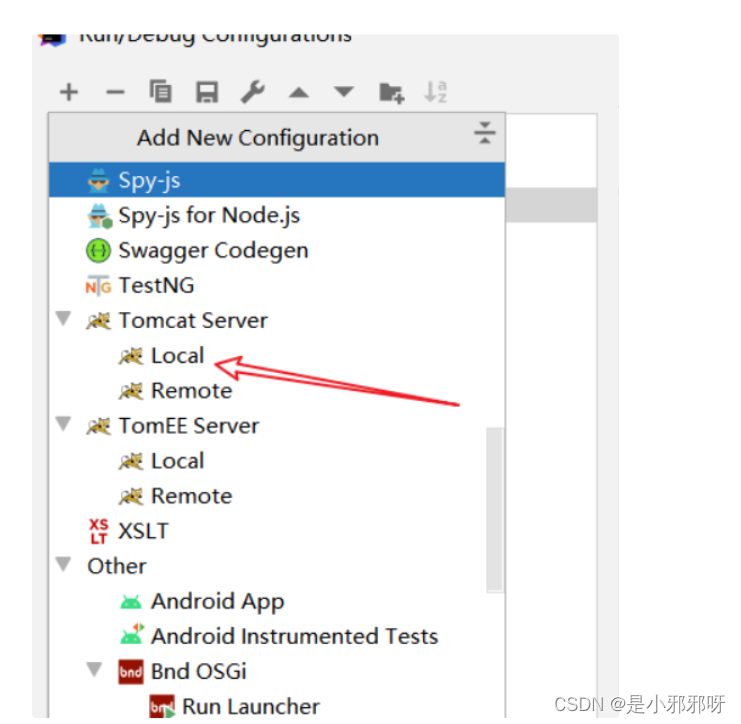
添加Tomcat Serve下的Local
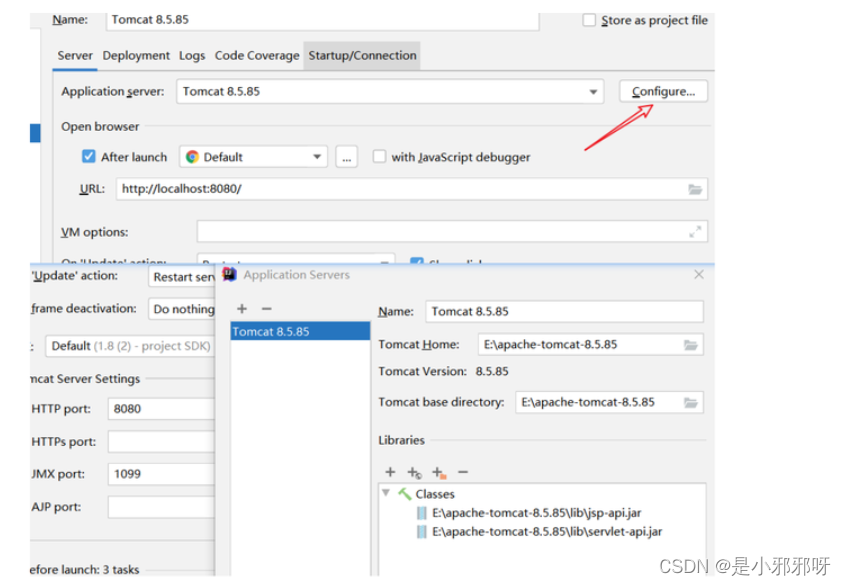
选择下载好后的Tomcat路径
⑧运行
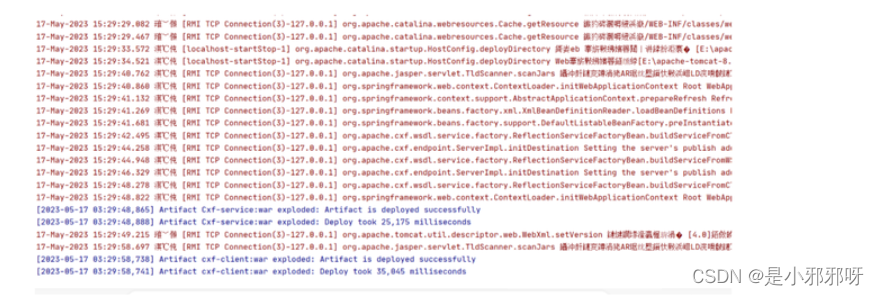
运行结果

在跳转的页面输出url映射
点击{http://service.ws.gec.com/}ProductServiceImplService后跳转的页面
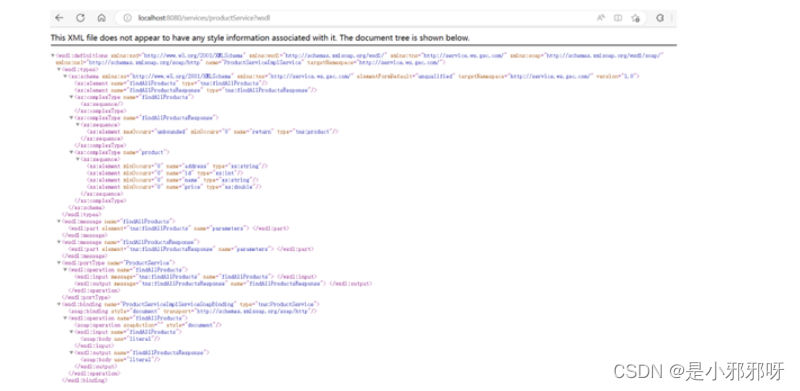
点击链接跳转后的页面
客户端
![]()
 客户端整体架构
客户端整体架构
①创建客户端web项目,导入CXF的类库。
②把服务端的实体类和接口与包一起拷贝过来
Product类
package com.gec.ws.pojo;
import java.io.Serializable;
public class Product implements Serializable {
private Integer id;
private String name;
private Double price;
private String address;
public Product() {
}
public Product(Integer id, String name, Double price, String address) {
this.id = id;
this.name = name;
this.price = price;
this.address = address;
}
public Integer getId() {
return id;
}
public void setId(Integer id) {
this.id = id;
}
public String getName() {
return name;
}
public void setName(String name) {
this.name = name;
}
public Double getPrice() {
return price;
}
public void setPrice(Double price) {
this.price = price;
}
public String getAddress() {
return address;
}
public void setAddress(String address) {
this.address = address;
}
}
ProductService接口
package com.gec.ws.service;
import com.gec.ws.pojo.Product;
import javax.jws.WebService;
import java.util.List;
@WebService //当前是一个可发布的web接口
public interface ProductService {
public List<Product> findAllProducts();
}
③创建com.gec.ws.main包
④以Spring的方式创建远程方法调用的客户端(代理)
package com.gec.ws.main;
import com.gec.ws.pojo.Product;
import com.gec.ws.service.ProductService;
import org.springframework.context.ApplicationContext;
import org.springframework.context.support.ClassPathXmlApplicationContext;
import java.util.List;
//怎样区分远程方法调用(边界),以JVM为标准
public class SpringClientTest {
public static void main(String[] args) {
ApplicationContext context=new ClassPathXmlApplicationContext("applicationContext.xml");
//远程方法调用的代理接口实例
ProductService productService= (ProductService) context.getBean("productService");
List<Product> list=productService.findAllProducts();
for (Product product : list) {
System.out.println(product.getId()+", "+product.getName()+", "+product.getPrice()+", "+product.getAddress());
}
}
}
⑤以代理的方式创建远程方法
package com.gec.ws.main;
import com.gec.ws.pojo.Product;
import com.gec.ws.service.ProductService;
import org.apache.cxf.jaxws.JaxWsProxyFactoryBean;
import java.util.List;
public class ProxyClientTest {
public static void main(String[] args) {
JaxWsProxyFactoryBean factory=new JaxWsProxyFactoryBean();
factory.setServiceClass(ProductService.class);
factory.setAddress("http://localhost:8088/services/productService");
ProductService productService= (ProductService) factory.create();
List<Product> list=productService.findAllProducts();
for (Product product : list) {
System.out.println(product.getId()+", "+product.getName()+", "+product.getPrice()+", "+product.getAddress());
}
}
}
⑥运行以Spring方式创建的远程方法
![]()
 Spring方式创建远程方法运行结果
Spring方式创建远程方法运行结果
⑦运行以代理方式创建的远程方法
![]()
 代理方式创建远程方法运行结果
代理方式创建远程方法运行结果
⑧没用到WebService之前调用远程方法的写法
package com.gec.ws.controller;
import com.gec.ws.service.ProductService;
import org.springframework.beans.factory.annotation.Autowired;
import org.springframework.stereotype.Controller;
@Controller
public class ProductController {
@Autowired
private ProductService productService; //远程方法调用webservice
}





















 2051
2051











 被折叠的 条评论
为什么被折叠?
被折叠的 条评论
为什么被折叠?










